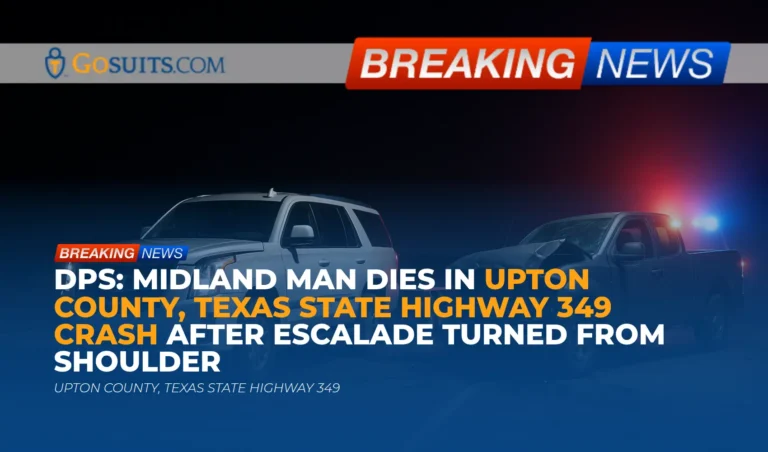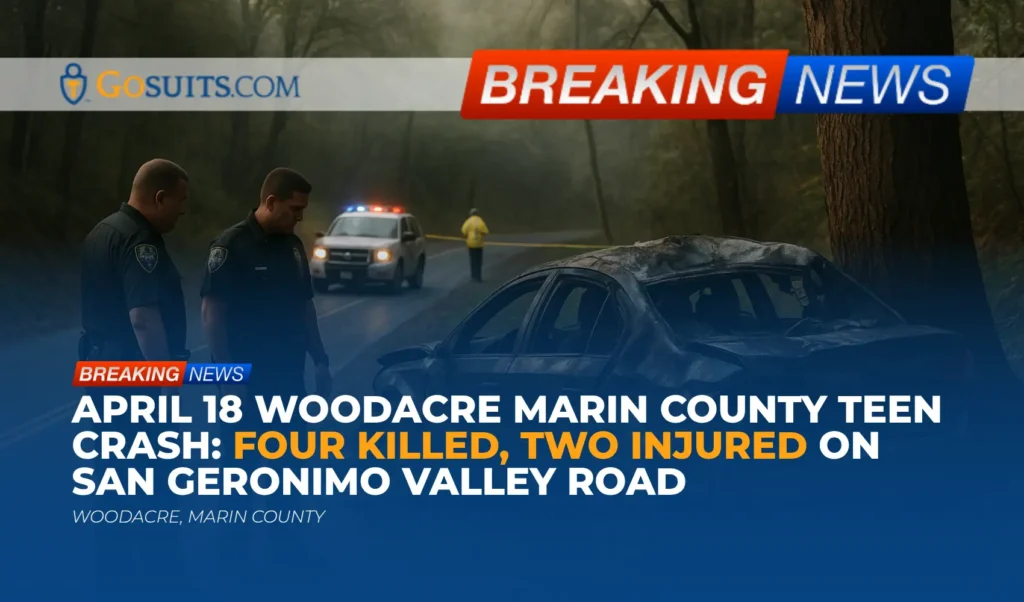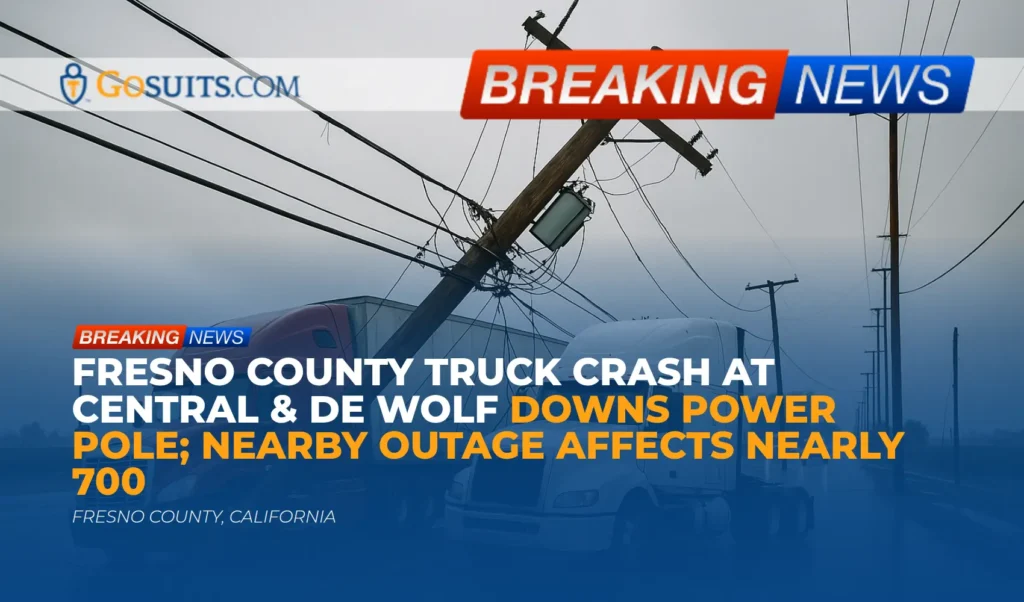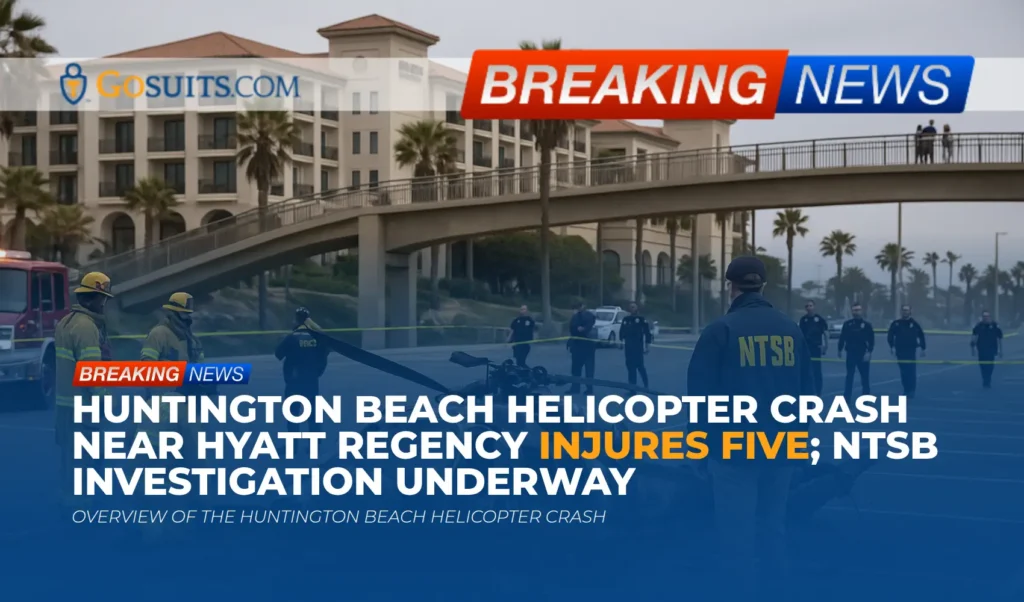- What we know about the Upton County crash on SH 349
- Timeline and location details released by DPS
- Safety context: nighttime driving and shoulder reentry risks
- Legal perspective: duties when turning or reentering a highway in Texas
- Potential civil liability and insurance implications
- Steps to obtain official records and information
- Preserving evidence and documenting losses
- How wrongful death and survival claims work in Texas
- Practical next steps before speaking with insurance companies
- Community safety observations for State Highway 349
- Commentary from Gosuits Upton County, Texas Personal Injury Attorney
- Why timely action matters
- Government sources referenced
What we know about the Upton County crash on SH 349
According to information released by the Texas Department of Public Safety, a two-vehicle crash occurred late Friday night in Upton County, Texas, resulting in the death of a Midland man. The collision involved an Escalade towing a trailer and a southbound pickup truck. Officials indicated the Escalade had been parked on the highway shoulder and then made an unsafe turn into the path of the oncoming pickup. The pickup collided with the trailer. The pickup’s driver, identified by authorities as 38-year-old Gerardo Garcia of Midland, was pronounced deceased at the scene. The Escalade’s driver was reportedly uninjured. The crash is under active investigation.
This summary reflects publicly reported facts at the time of writing. As with any serious crash, a full reconstruction and additional findings from law enforcement and any forensic examinations may be forthcoming in the days and weeks ahead.
Timeline and location details released by DPS
Time and date
The crash occurred around 11:30 p.m. on Friday, October 10, 2025. Nighttime conditions can add complexity for investigators and families alike because visibility, lighting, traffic volumes, and driver fatigue often factor into late-night highway incidents.
Location
The incident took place along State Highway 349 near mile marker 376 in Upton County, Texas. SH 349 is a significant north-south corridor in the Permian Basin region, used by both local traffic and vehicles engaged in regional commerce. Shoulders on rural state highways can vary in width and condition, and the safety of reentering traffic depends heavily on sight distance, lighting, driver signaling, and speed differentials.
Safety context: nighttime driving and shoulder reentry risks
Night driving presents reduced visibility and a shortened window for drivers to detect and respond to hazards. The National Highway Traffic Safety Administration notes that limited visibility at night, glare, and fatigue increase risk on the road and recommends extra caution after dark, including reducing speed and increasing following distance. For more on night driving risks and safe practices, see NHTSA’s guidance on night driving.
Reentering a highway from the shoulder requires heightened care. Traffic on the main lanes is typically moving at or near highway speeds, and a vehicle merging or turning from a stopped position must ensure adequate gaps, proper signaling, and full awareness of approaching traffic. A driver’s decisions at the moment of reentry can be decisive for safety, particularly at night when other motorists have less time to perceive and react.
Legal perspective: duties when turning or reentering a highway in Texas
General duties for turning and merging
Texas law imposes specific duties on drivers who turn or reenter traffic:
- Signal and safety before turning: Texas Transportation Code requires drivers to use an appropriate signal before turning and to ensure the movement can be made safely. See Transportation Code §545.104.
- Driving on and reentering from the shoulder: Texas restricts driving on improved shoulders and contemplates reentry only under conditions that promote safety and do not interfere with other traffic. See §545.058.
- Entering a controlled-access highway: A driver entering the main lanes of a controlled-access highway must yield the right of way to vehicles on the main lanes. See §545.154.
While the precise application depends on the final investigative findings, these provisions reflect the general principle that a driver moving from a stopped position on or near the shoulder must exercise caution, signal intentions, and yield to through traffic when required to do so safely.
Civil responsibility in Texas
Civil claims in Texas are governed in part by the state’s proportionate responsibility framework. If more than one party is alleged to have contributed to a crash, a fact finder may assign percentages of responsibility. Importantly, a claimant cannot recover damages if they are found to be more than 50 percent responsible for the incident. See Texas Civil Practice and Remedies Code §33.001. These rules are central when evaluating liability and negotiating with insurance carriers after a highway collision.
Potential civil liability and insurance implications
Possible liability considerations
Based on the statements attributed to DPS, the Escalade was parked on the shoulder and then turned in front of a southbound pickup, after which the pickup struck the trailer. In a civil negligence analysis, investigators and insurers typically consider:
- Whether the turning driver signaled and ensured a safe gap before entering the travel lanes under §545.104.
- Whether reentry from the shoulder was executed safely and without interfering with traffic, consistent with §545.058 and general right-of-way principles.
- Visibility and nighttime conditions affecting both drivers’ ability to perceive and react.
- Speed and lane positioning of the southbound pickup, and whether there were any contributing roadway or environmental factors.
- Status of the trailer and tow vehicle including lighting, reflectors, and conspicuity, particularly relevant at night.
No definitive conclusions can be drawn until the investigation is complete, but the accounts provided by DPS frame core issues that typically arise in a civil negligence inquiry, including right of way, signaling, and safe reentry.
Insurance coverage pathways
Depending on the facts and vehicle ownership, several insurance layers may be relevant:
- Liability coverage of the driver who turned into the roadway and any owner of the trailer or tow vehicle.
- Uninsured/underinsured motorist coverage on the pickup’s policy, which may be implicated if at-fault coverage is inadequate.
- PIP or MedPay benefits, if applicable, which can address certain medical or funeral expenses regardless of fault, subject to policy terms.
- Commercial policies if the trailer or tow vehicle was being used for work. If a business was involved, federal and state safety regulations may inform the standard of care. See the Federal Motor Carrier Safety Administration’s regulations overview at FMCSA.
Insurance companies will quickly evaluate fault, often relying on officer narratives, scene measurements, and witness statements. Policyholders and families should be aware that early recorded statements and casual remarks can influence fault determinations and claim decisions. It is prudent to consult with an attorney before giving any statement to an insurer. What is said to an insurance company can be used against the claimant later.
Steps to obtain official records and information
Crash reports
In Texas, law enforcement officers complete a CR-3 crash report for collisions investigated on public roadways. Release of crash reports is governed by statute, and certain individuals and entities are authorized to obtain a copy. See Transportation Code §550.065. The Texas Department of Transportation maintains crash records and provides public access to eligible requestors. For process details, visit the TxDOT website’s crash records information at TxDOT and navigate to the crash records section.
The investigating agency for this highway area is typically the Texas Department of Public Safety Highway Patrol. Families may also contact the local DPS regional office to confirm report availability and obtain the report number once assigned.
Inquest and autopsy records
Texas handles death investigations through either a county medical examiner’s office or the local justice of the peace in counties without a medical examiner. The Justice of the Peace may conduct an inquest and can order an autopsy when required by law. See Texas Code of Criminal Procedure, Chapter 49. In counties served by a medical examiner, autopsy reports are generally public records under CCP §49.25, with certain sensitive materials like photographs protected from disclosure. Next of kin can typically request certified copies for personal and legal needs.
For Upton County, families can reach out to the Upton County Justice of the Peace office or the county clerk to determine whether an inquest was conducted and where the records are maintained, as procedures can vary. If a regional medical examiner performed the autopsy, that office will have instructions for requesting the report.
Towing, vehicle storage, and scene documentation
If vehicles were towed from the scene, the investigating agency can usually provide the tow company name and storage lot location. Promptly locating and documenting the vehicles can be important for inspections and data downloads. Timely requests help ensure critical evidence remains available.
Whom to contact for specific records
- Crash report: Texas Department of Transportation crash records portal via TxDOT and, for status and the report number, the Texas DPS Highway Patrol office that investigated the crash. Eligibility and confidentiality rules are at Transportation Code §550.065.
- Inquest/autopsy: Upton County Justice of the Peace or, if applicable, the regional medical examiner’s office. Authority and procedures are outlined in CCP Chapter 49.
- Scene photos/measurements: Typically maintained by the investigating agency. Some materials may be releasable through an open records request consistent with Texas law.
- 911 audio and dispatch logs: Often requested through the county or regional communications center, subject to applicable release rules.
Preserving evidence and documenting losses

Vehicle evidence and onboard data
Modern vehicles often record Event Data Recorder information that can include speed, throttle, braking, and other pre-crash parameters. Preserving and downloading EDR data should be done promptly and correctly. For background on EDRs, see NHTSA’s overview at NHTSA EDR. In trailer collisions, documenting trailer lighting, reflectivity, and wiring is also important, particularly after a nighttime crash.
Photographs and physical measurements
Early photographs of vehicle damage, the trailer connection and lighting, skid marks, debris fields, and any nearby lighting or signage can support a reconstruction. Measurements of sight lines and distances to curves or crests can be relevant to a safe reentry analysis.
Medical, funeral, and economic records
Families should keep receipts and records for medical attempts at lifesaving care, transport, funeral and burial expenses, and other immediate costs. Employment records and tax documents can help quantify income-related losses. Diaries or statements describing the human impact may be appropriate to prepare for later stages of a claim.
How wrongful death and survival claims work in Texas
Who may bring claims
Texas law allows certain family members to pursue a wrongful death claim arising from a fatal injury caused by the wrongful act, neglect, carelessness, unskillfulness, or default of another. Generally, the surviving spouse, children, and parents may bring a wrongful death action. The estate may also have a survival claim to recover damages the decedent could have sought if they had lived. See Texas Civil Practice and Remedies Code, Chapter 71.
Time limits
Most wrongful death and survival actions in Texas must be filed within two years of the date of death, though specific circumstances can affect limitations. See Texas Civil Practice and Remedies Code §16.003. Because time can pass quickly amid grief and logistics, understanding and protecting deadlines is key.
Damages overview
Without predicting any outcomes, Texas law recognizes categories of damages that may be available in wrongful death and survival cases, subject to proof. These can include economic losses, certain noneconomic harms, funeral expenses, and, in limited cases, exemplary damages. Chapter 71 of the Civil Practice and Remedies Code outlines the legal framework for these claims and the eligible beneficiaries.
Practical next steps before speaking with insurance companies
Proceed carefully with insurers
Insurers for drivers and trailer owners often reach out quickly after a fatal crash. They may request recorded statements or ask for details about the event and its impact. It is advisable to speak with an attorney first before talking to any insurance company. What someone shares in those early conversations can be used to challenge fault or limit compensation later.
Document first, communicate thoughtfully
- Collect key identifiers: crash report number, investigating agency, towing company, and storage lot.
- Preserve text messages and call logs from any witnesses or responders who reached out.
- Keep a single file with receipts and documents to minimize lost information.
- Ask about vehicle preservation before any repairs or disposal, so inspections and downloads can occur if needed.
Potential third-party evidence
Nearby businesses or highway cameras may have footage. Some recordings are overwritten in days. Written preservation requests, including to any known businesses near mile marker 376, may help prevent deletion of useful video.
Community safety observations for State Highway 349
State Highway 349 carries a mix of personal and commercial traffic through the Permian Basin. Nighttime conditions, limited ambient lighting, and shoulder use by disabled or stopped vehicles can create hazards for reentry into fast-moving lanes. Where trailers are involved, ensuring that lighting and reflectors are functioning is especially important to provide approaching drivers with adequate warning.
Public safety agencies and roadway users share responsibility for reducing risk. NHTSA’s night driving guidance emphasizes speed management, increased following distance, and vigilance after dark. For heavy or trailer-towing vehicles, careful planning before reentering a highway and verifying that the path is clear and the vehicle is properly illuminated are vital steps that can save lives. Resources for safe night driving are available from NHTSA at this page.
Commentary from Gosuits Upton County, Texas Personal Injury Attorney
Our hearts go out to the family and loved ones affected by the crash on State Highway 349. We are deeply sorry for their loss. This article is shared for educational purposes and general information, with respect for everyone involved and the ongoing investigation.
From a civil personal injury perspective, the details reported by DPS point to critical questions about a turn from the shoulder into the path of a southbound pickup at night. Texas law expects drivers reentering a highway to signal and ensure the movement can be made safely without interfering with traffic. When a trailer is involved, conspicuity and timing become even more important. The investigation will determine the facts, but these are the types of issues that often define liability in highway collisions.
In the aftermath of a fatal crash, insurance companies and corporate risk managers move quickly. They understand how uncertainty, grief, and the unfamiliarity of the process can make it difficult for families to protect their interests. Adjusters may seek recorded statements or early agreements that frame the narrative in a way that benefits the insurer. It is important to remember that what a person says to an insurance company can be used against them later. Speaking with a seasoned attorney before engaging with insurers helps ensure rights are understood and that crucial evidence is preserved. Most firms offer a free consultation, which allows families to get oriented without financial pressure.

Why timely action matters
What to do
- Secure official documents: Obtain the crash report when available through the Texas Department of Transportation and confirm inquest or autopsy records through the proper county authority.
- Preserve evidence immediately: Ask that vehicles and trailers be preserved for inspection and consider written preservation notices for potential video or third-party records.
- Consult a qualified attorney before any insurance statements: Learn about rights, options, and deadlines, and avoid informal conversations that could be misunderstood or taken out of context.
- Organize records: Keep a centralized folder with medical papers, funeral expenses, employment and income documents, and correspondence with agencies and insurers.
Why act now
- Evidence is time-sensitive: Vehicles may be repaired or sold, electronic data can be lost, and surveillance footage is often overwritten within days.
- Legal deadlines apply: Texas law imposes statutes of limitations for wrongful death and related claims. Understanding these timelines early helps avoid forfeiting rights. See §16.003.
- Insurance narratives form quickly: Early statements can shape fault assessments. Planning communications prevents unintended admissions or inaccuracies.
- Peace of mind: Having a plan for documents, communications, and next steps helps reduce confusion during a difficult time.
Government sources referenced
- National Highway Traffic Safety Administration: Night Driving
- National Highway Traffic Safety Administration: Event Data Recorder
- Federal Motor Carrier Safety Administration: Regulations
- Texas Transportation Code §545.104: Turning; Signaling
- Texas Transportation Code §545.058: Driving on Improved Shoulder
- Texas Transportation Code §545.154: Entering or Leaving Controlled-Access Highway
- Texas Transportation Code §550.065: Release of Accident Report
- Texas Civil Practice and Remedies Code §33.001: Proportionate Responsibility
- Texas Civil Practice and Remedies Code, Chapter 71: Wrongful Death and Survival
- Texas Civil Practice and Remedies Code §16.003: Limitations
- Texas Code of Criminal Procedure, Chapter 49: Inquests and Autopsies






